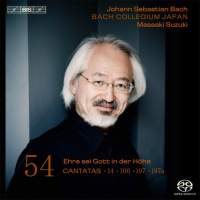Texte paru dans: / Appeared in:

Fanfare Magazine: 37:4 (03-04/2014)
Pour
s'abonner / Subscription information
Les abonnés à Fanfare Magazine ont accès aux archives du
magazine sur internet.
Subscribers to Fanfare Magazine have access to the archives of the magazine
on the net.
BIS
BIS2021

Code-barres / Barcode : 7318599920214 (ID408)
As his momentous series nears its conclusion, Masaaki Suzuki turns his attention to three late cantatas, all presumably composed in the mid-1730s, all richly scored. Cantata No. 100’s two horns (and timpani), flute, and oboe d’amore suggest a festive occasion, but actually which one is not known. Cantata No. 197, with three trumpets, two oboes, and an obbligato bassoon, was composed for a wedding, although, again, the principals are unknown. Given the lavish score—10 numbers divided into two parts—it’s fairly safely assumed that they were persons of rank. Little did they suspect that by simply affixing their names to the score they could have achieved immortality—of a sort! Cantata No. 14 was composed for the fourth Sunday after Epiphany in 1735. Its scoring includes one trumpet, a horn, and two oboes. Bach wrote No. 14 to fill a gap in his chorale cantata cycle of 1724–25; there was no fourth Sunday after Epiphany in 1725. It opens with a contrapuntally complex motet-style chorus, a harbinger, perhaps of The Art of Fugue, which must have been percolating in Bach’s mind at the time. BWV 100 has the distinction of being one of four Leipzig cantatas (along with 97, 117, and 192) in which all movements are based on the chorale melody. It’s also one of the few cantatas without recitatives. Ever the tinkerer, Bach drew upon an existing Christmas cantata for some of BWV 197. Only three movements and a part of a fourth of the earlier cantata have survived. In crafting a viable, performable fragment, the musicologist Diethard Hellmann has returned the favor, in a way, basing his reconstruction of its incomplete alto aria on Bach’s second thoughts.
The reconstructed aria, accompanied by a pair of flutes, is tenderly realized by Damien Guillon. Hana Blažíková is brilliant in her aria with trumpet in Cantata No. 14. Gerd Türk and Peter Kooij are their usual dependable selves. The chorus and orchestra—all Japanese except for the solo quartet and the two hornists/trumpeters—are predictably excellent as well. Masaaki’s direction is masterful, as always. It’s another triumph for Suzuki and the Bach Collegium Japan.
Cliquez l'un ou l'autre
bouton pour découvrir bien d'autres critiques de CD
Click either button for many other reviews


